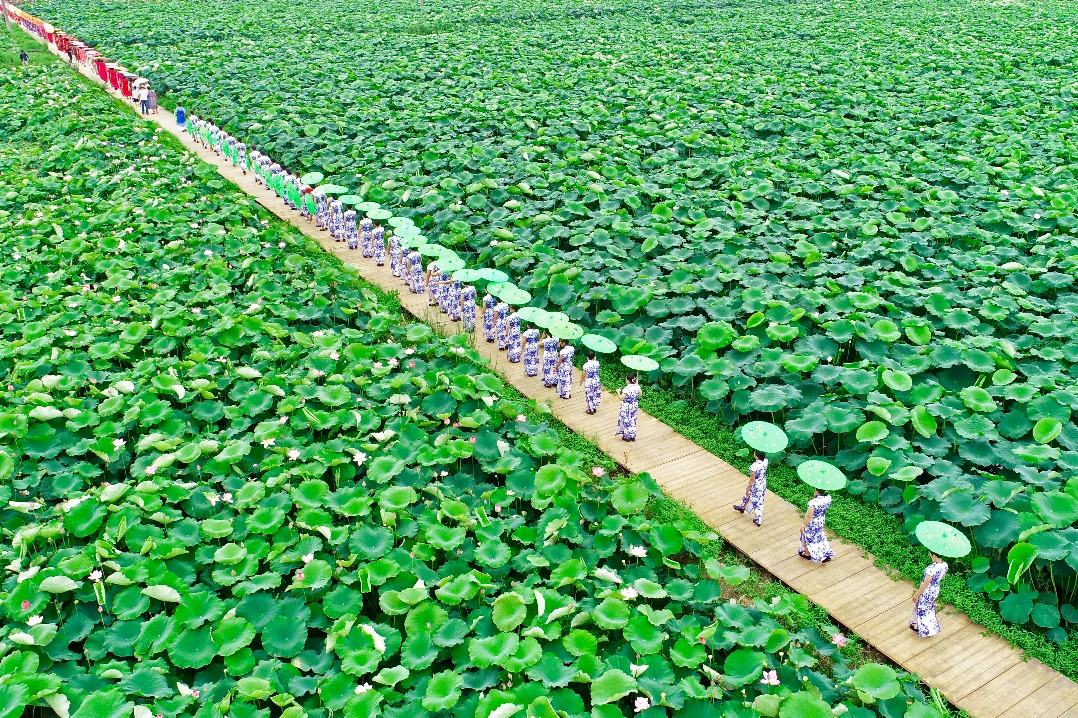Smart farming turns desert into oasis

URUMQI — In the arid hinterlands of Northwest China, where barren expanses dominate the landscape, a high-tech greenhouse is defying local harsh conditions, producing vibrant greens and sweet strawberries year-round with minimal water and zero pesticides.
The smart farm built last May in Kuqa of Xinjiang Uygur autonomous region with funding from Ningbo, Zhejiang province of East China, uses hydroponics and automated climate control to grow leafy greens and strawberries unaffected by the dry, dusty surroundings of the Taklimakan Desert, the world's second-largest shifting sand desert.
The indoor farm of nearly 7,000 square meters is part of China's push to modernize rural economies through tech-aided agriculture with Xinjiang, where deserts cover 25 percent of the land as a key testing ground.
Inside the plant factory, rows of spinach, lettuce and ruby-red strawberries thrive under glass, their roots bathed in nutrient-rich water instead of soil. Sensors adjust temperature, humidity and irrigation automatically, while workers monitor data dashboards — a far cry from traditional farming in this snow-melt-dependent region.
Local farmer Eli Kerim has a part-time job there, managing roughly 0.27 hectares of strawberries. His daily work has gone beyond physical labor such as pruning and picking to monitoring growth data and conducting necessary analysis. "The work here expands my skills and knowledge, and I frequently consult with our technicians whenever I have a problem," says the 29-year-old.
"We tailor crops to market demand. Our first strawberry harvest sold out instantly," says Zhang Yaping, manager of the greenhouse. The greenhouse provides 26 jobs and is expected to boost annual incomes by 40,000 yuan ($5,554) per worker while paying 700,000 yuan in collective rent and sweet equity dividends to a local village a year.
Li Xiandong, an associate professor at the College of Economics and Management of Xinjiang Agricultural University, sees broader potential. Such smart agricultural facilities could significantly increase the planting area and yield of crops and help drive the industrial upgrading of the surrounding areas, he says.
At another agricultural demonstration zone in northern Xinjiang's Changji Hui autonomous prefecture, leafy vegetables like amaranth are planted in 10-layer vertical racks that can rotate 360 degrees, ensuring crops absorb sunlight evenly and efficiently increasing the utilization of space. For climbing plants such as tomatoes, vines sprawling as long as 13 meters are hung over a rope beneath the glasshouse ceiling and roots are immersed in nutrient solutions, maximizing their exposure to sunlight and fertilizer.
Senior agronomist Yan Ji stands on a hydraulic vehicle that can be lifted vertically or moved laterally on a rail, thus allowing him to easily prune side stems and leaves, or harvest tomatoes. "Here we do most of our work in a standing posture, and seldom bend at the waist or squat for a long time," he says. "High-tech relieves us of heavy manual labor."
Yan notes that the factory's cultivation uses a reasonable combination of artificial and natural light, a mix of nutrients based on scientifically determined proportions, and an isolated environment that reduces the impacts of diseases and pests. "As a result, our tomatoes are of fine quality, enjoy higher yields and sell at better prices," Yan says. According to him, the harvest season lasts from October to July, with a daily output exceeding 300 kilograms.
In recent years, Xinjiang has attached great importance to the development of facility agriculture, including smart farming. As of 2023, the region had more than 1.2 million facility agriculture units, involving a vegetable plantation area exceeding 44,600 hectares in total, according to local department of agriculture and rural affairs.
Xinhua




































